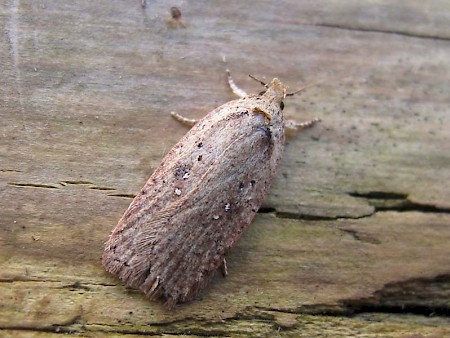32.011 BF704
Agonopterix scopariella
(Heinemann, 1870)
Wingspan 18-21 mm.
In Britain, this species is widespread, but local, usually in the vicinity of the foodplant. Pre-1979, records were often confused with A. atomella.
A. scopariella is variable, but usually has two black spots on the wing at one third of its length from its base, and two white spots at three fifths of the wing length. The white spots are often ringed by black scales. The black spots often have some white scales on their edges, and, occasionally, the black is entirely replaced by white. Adults which have not been reared from larvae on broom (Cytisus scoparius) may be confused with A. atomella, A. heracliana or A. subpropinquella, and examination of genitalia is advised.
Adults occur August to April, hibernating over winter.
Larvae feed, June to late July, on spun shoots of broom (Cytisus scoparius), and might be confused with green forms of A. nervosa.
- Larva: (description Ian F. Smith):
Foodplants: June to late July (possibly early August) in spun shoots of Cytisus scoparius or Lupinus arboreus
Early instar (Based on Langmaid, 1979)
Head: Black.
Prothoracic shield: Black.
Body: Green, or pale green.
Pinacula: Black.
Late instar
Length: 15 mm described
Head: Ochre or greenish ochre. Small brown posterolateral mark. Small brown mark in stemmatal area.
Prothoracic shield: Translucent, slightly tinted ochre, showing ochre of head and green body. Divided by thin unobtrusive paler medial line. Lateral edge has two black dots, often merged into a crescentic line.
Thoracic legs: Translucent yellowish brown.
Body: Light green. Yellow intersegmentally on abdomen. Greyish green dorsal
line and broad dorsolateral line.
Spiracles: Black.
Pinacula: Small. Black.
Setae: Translucent brownish.
Anal plate: Translucent, very faintly tinted ochre, showing green of body.
Prolegs: Pale greenish. Crochets reddish brown.
Similar species
On Cytisus scoparius:
Late instar larvae may resemble green forms of A. nervosa. But in June, when their larval stages overlap, A. nervosa is usually well grown, while A. scopariella is usually smaller. A. nervosa can be distinguished by its blackish (sometimes brown) thoracic legs, dark brown head and larger pinacula. (But note that early instar A. scopariella has a black head and prothoracic shield.)

 UKMoths
UKMoths 





